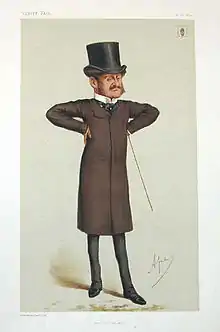
Sir George Orby Wombwell, 4th Baronet (23 November 1832 – 16 October 1913)[1] was a British baronet.
Early life
Wombwell was born on 23 November 1832. He was the son of Sir George Wombwell, 3rd Baronet and educated at Eton College and Royal Military College, Sandhurst.
Career
He joined the 17th Lancers in 1852 as a cornet and served as an aide-de-camp to Lord Cardigan. He was a survivor of the Charge of the Light Brigade. When he had reached the guns, his horse was killed under him and he was shortly after pulled off and taken prisoner, his sword and pistols being taken from him by some Russian Lancers. He managed to escape, catch another loose horse and ride back to the British lines, hotly pursued by Russians.[2]
He retired from the Army as a lieutenant in 1855, when he inherited his title and Newburgh Priory, the old seat of the Belasyses, in Coxwold, North Yorkshire, on the death of his father. Included in this estate was Over Silton Manor, where Wombwell's initials (GOW) can still be seen on one of the manor cottages, and High House, at Thornton-on-the-Hill.[3]
He was appointed High Sheriff of Yorkshire in 1861.[4]
Personal life
He married Lady Julia Sarah Alice Child-Villiers, daughter of George Child-Villiers, 6th Earl of Jersey and Julia Peel, on 3 September 1861. They had two sons, who both died on active service, and three daughters:[5]
- George Wombwell (1865–1889), a lieutenant with the King's Royal Rifle Corps, died at Meerut in India
- Stephen Frederick Wombwell (1867–1901), a lieutenant in the Yorkshire Hussars, died of Enteric fever at Vryburg in South Africa during the Second Boer War while serving as a captain with the Imperial Yeomanry.[6][7]
- Julia Georgiana Wombwell (b. 1862), who married firstly Vesey Dawson, 2nd Earl of Dartrey in 1890 and secondly, late in life, John St Aubyn, 2nd Baron St Levan.[8][9]
- Mabel Caroline Wombwell (b.1863) who married Henry Robert Hohler.
- Cecilia Clementina Wombwell (b. 1864) who married William Menzies.
At his death he was the last surviving officer of the Charge of the Light Brigade and was buried in Coxwold churchyard. His title and 12,000 acre estate passed to his younger brother Henry Herbert Wombwell.
 |
|
Picture of 4th Baronet
References
- ↑ "p. 5281 § 52806". Retrieved 16 November 2010.
- ↑ "17th Lancers". Retrieved 12 February 2015.
- ↑ Historic England. "High House (Grade II*) (1150731)". National Heritage List for England. Retrieved 26 August 2014.
- ↑ "Nov 13 1860 Nomination of Sheriffs". Cumberland and Westmorland Newspaper Transactions. Retrieved 16 November 2010.
- ↑ Burke's Peerage, Baronetage and Knightage, 100th Edn, London, 1953.
- ↑ Yorkshire Hussars at British Empire.
- ↑ "photo". flickr. Retrieved 16 November 2010.
- ↑ "p. 5281 § 52806". Retrieved 15 November 2010.
- ↑ Moseley, Brian (19 February 2011). "The Lords Saint Levan". The Encyclopaedia of Plymouth History. Archived from the original on 29 April 2012. Retrieved 12 February 2015.
- ↑ Burke's genealogical and heraldic history of the peerage, baronetage, and knightage, Privy Council, and order of preference. 1949.
- Bibliography
- Mosley, Charles (2004). Burke's Peerage and Baronetage of Great Britain and Ireland (106th ed.). London: Cassells.
- Kidd, Charles (2014). Debrett's Peerage and Baronetage. London: Macmillan.
- Cokayne, George E; Doubleday, Henry A.; Gibbs, Vicary (1937–1949). The Complete Peerage and Baronetage of Great Britain and Ireland, extant, dormant and abeyant. London: St Catherine's Press.
External links
- leighrayment.com[usurped]
- http://www.peerage.com